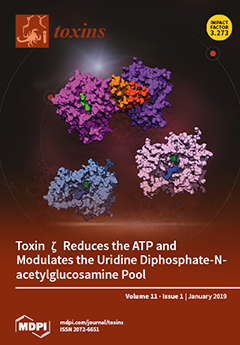The physiological and toxicological characteristics of
Dinophysis acuminata have been increasingly studied in an attempt to better understand and predict diarrhetic shellfish poisoning (DSP) events worldwide. Recent work has identified prey quantity, organic nitrogen, and ammonium as likely contributors to increased
Dinophysis growth
[...] Read more.
The physiological and toxicological characteristics of
Dinophysis acuminata have been increasingly studied in an attempt to better understand and predict diarrhetic shellfish poisoning (DSP) events worldwide. Recent work has identified prey quantity, organic nitrogen, and ammonium as likely contributors to increased
Dinophysis growth rates and/or toxicity. Further research is now needed to better understand the interplay between these factors, for example, how inorganic and organic compounds interact with prey and a variety of
Dinophysis species and/or strains. In this study, the exudate of ciliate prey and cryptophytes were investigated for an ability to support
D. acuminata growth and toxin production in the presence and absence of prey, i.e., during mixotrophic and phototrophic growth respectively. A series of culturing experiments demonstrated that the addition of ciliate lysate led to faster dinoflagellate growth rates (0.25 ± 0.002/d) in predator-prey co-incubations than in treatments containing (1) similar levels of prey but without lysate (0.21 ± 0.003/d), (2) ciliate lysate but no live prey (0.12 ± 0.004/d), or (3) monocultures of
D. acuminata without ciliate lysate or live prey (0.01 ± 0.007/d). The addition of ciliate lysate to co-incubations also resulted in maximum toxin quotas and extracellular concentrations of okadaic acid (OA, 0.11 ± 0.01 pg/cell; 1.37 ± 0.10 ng/mL) and dinophysistoxin-1 (DTX1, 0.20 ± 0.02 pg/cell; 1.27 ± 0.10 ng/mL), and significantly greater total DSP toxin concentrations (intracellular + extracellular). Pectenotoxin-2 values, intracellular or extracellular, did not show a clear trend across the treatments. The addition of cryptophyte lysate or whole cells, however, did not support dinoflagellate cell division. Together these data demonstrate that while certain growth was observed when only lysate was added, the benefits to
Dinophysis were maximized when ciliate lysate was added with the ciliate inoculum (i.e., during mixotrophic growth). Extrapolating to the field, these culturing studies suggest that the presence of ciliate exudate during co-occurring dinoflagellate-ciliate blooms may indirectly and directly exacerbate
D. acuminata abundance and toxigenicity. More research is required, however, to understand what direct or indirect mechanisms control the predator-prey dynamic and what component(s) of ciliate lysate are being utilized by the dinoflagellate or other organisms (e.g., ciliate or bacteria) in the culture if predictive capabilities are to be developed and management strategies created.
Full article






